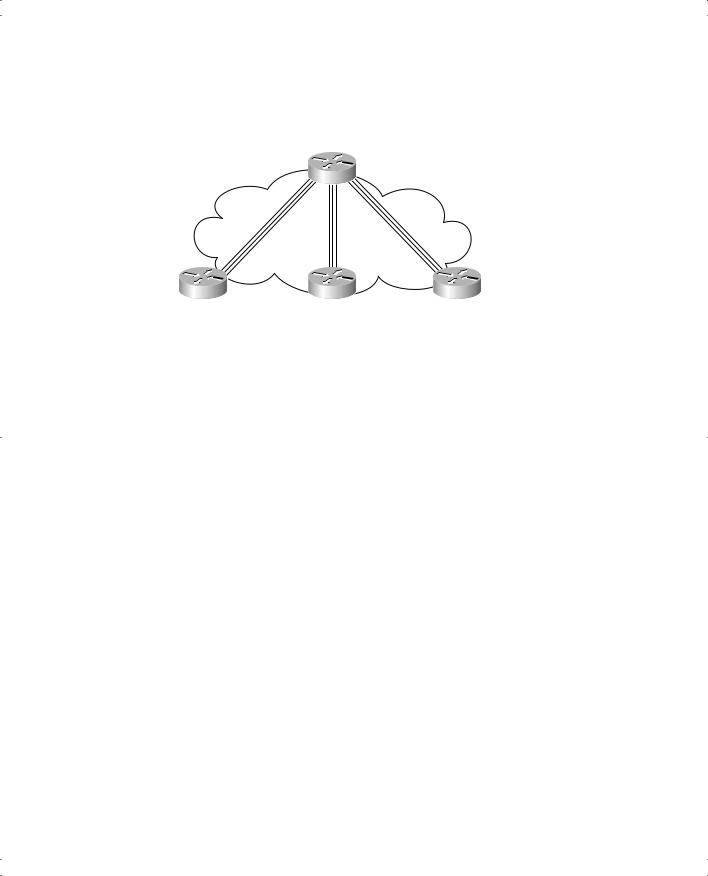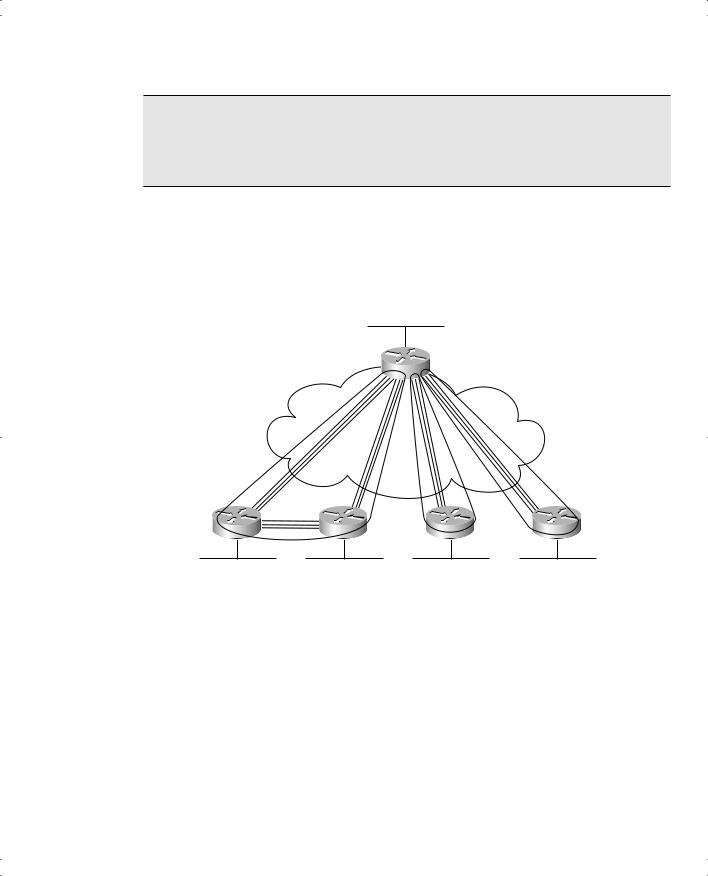
- •Warning and Disclaimer
- •Feedback Information
- •Trademark Acknowledgments
- •About the Author
- •About the Technical Reviewers
- •Dedication
- •Acknowledgments
- •Contents at a Glance
- •Contents
- •Icons Used in This Book
- •Command Syntax Conventions
- •Cisco’s Motivation: Certifying Partners
- •Format of the CCNA Exams
- •What’s on the CCNA Exams
- •ICND Exam Topics
- •Cross-Reference Between Exam Topics and Book Parts
- •CCNA Exam Topics
- •INTRO and ICND Course Outlines
- •Objectives and Methods
- •Book Features
- •How This Book Is Organized
- •Part I: LAN Switching
- •Part II: TCP/IP
- •Part III: Wide-Area Networks
- •Part IV: Network Security
- •Part V: Final Preparation
- •Part VI: Appendixes
- •How to Use These Books to Prepare for the CCNA Exam
- •For More Information
- •Part I: LAN Switching
- •“Do I Know This Already?” Quiz
- •Foundation Topics
- •Brief Review of LAN Switching
- •The Forward-Versus-Filter Decision
- •How Switches Learn MAC Addresses
- •Forwarding Unknown Unicasts and Broadcasts
- •LAN Switch Logic Summary
- •Basic Switch Operation
- •Foundation Summary
- •Spanning Tree Protocol
- •“Do I Know This Already?” Quiz
- •Foundation Topics
- •Spanning Tree Protocol
- •What IEEE 802.1d Spanning Tree Does
- •How Spanning Tree Works
- •Electing the Root and Discovering Root Ports and Designated Ports
- •Reacting to Changes in the Network
- •Spanning Tree Protocol Summary
- •Optional STP Features
- •EtherChannel
- •PortFast
- •Rapid Spanning Tree (IEEE 802.1w)
- •RSTP Link and Edge Types
- •RSTP Port States
- •RSTP Port Roles
- •RSTP Convergence
- •Edge-Type Behavior and PortFast
- •Link-Type Shared
- •Link-Type Point-to-Point
- •An Example of Speedy RSTP Convergence
- •Basic STP show Commands
- •Changing STP Port Costs and Bridge Priority
- •Foundation Summary
- •Foundation Summary
- •Virtual LANs and Trunking
- •“Do I Know This Already?” Quiz
- •Foundation Topics
- •Review of Virtual LAN Concepts
- •Trunking with ISL and 802.1Q
- •ISL and 802.1Q Compared
- •VLAN Trunking Protocol (VTP)
- •How VTP Works
- •VTP Pruning
- •Foundation Summary
- •Part II: TCP/IP
- •IP Addressing and Subnetting
- •“Do I Know This Already?” Quiz
- •Foundation Topics
- •IP Addressing Review
- •IP Subnetting
- •Analyzing and Interpreting IP Addresses and Subnets
- •Math Operations Used to Answer Subnetting Questions
- •Converting IP Addresses from Decimal to Binary and Back Again
- •The Boolean AND Operation
- •How Many Hosts and How Many Subnets?
- •What Is the Subnet Number, and What Are the IP Addresses in the Subnet?
- •Finding the Subnet Number
- •Finding the Subnet Broadcast Address
- •Finding the Range of Valid IP Addresses in a Subnet
- •Finding the Answers Without Using Binary
- •Easier Math with Easy Masks
- •Which Subnet Masks Meet the Stated Design Requirements?
- •What Are the Other Subnet Numbers?
- •Foundation Summary
- •“Do I Know This Already?” Quiz
- •Foundation Topics
- •Extended ping Command
- •Distance Vector Concepts
- •Distance Vector Loop-Avoidance Features
- •Route Poisoning
- •Split Horizon
- •Split Horizon with Poison Reverse
- •Hold-Down Timer
- •Triggered (Flash) Updates
- •RIP and IGRP
- •IGRP Metrics
- •Examination of RIP and IGRP debug and show Commands
- •Issues When Multiple Routes to the Same Subnet Exist
- •Administrative Distance
- •Foundation Summary
- •“Do I Know This Already?” Quiz
- •Foundation Topics
- •Link-State Routing Protocol and OSPF Concepts
- •Steady-State Operation
- •Loop Avoidance
- •Scaling OSPF Through Hierarchical Design
- •OSPF Areas
- •Stub Areas
- •Summary: Comparing Link-State and OSPF to Distance Vector Protocols
- •Balanced Hybrid Routing Protocol and EIGRP Concepts
- •EIGRP Loop Avoidance
- •EIGRP Summary
- •Foundation Summary
- •“Do I Know This Already?” Quiz
- •Foundation Topics
- •Route Summarization and Variable-Length Subnet Masks
- •Route Summarization Concepts
- •VLSM
- •Route Summarization Strategies
- •Sample “Best” Summary on Seville
- •Sample “Best” Summary on Yosemite
- •Classless Routing Protocols and Classless Routing
- •Classless and Classful Routing Protocols
- •Autosummarization
- •Classful and Classless Routing
- •Default Routes
- •Classless Routing
- •Foundation Summary
- •Advanced TCP/IP Topics
- •“Do I Know This Already?” Quiz
- •Foundation Topics
- •Scaling the IP Address Space for the Internet
- •CIDR
- •Private Addressing
- •Network Address Translation
- •Static NAT
- •Dynamic NAT
- •Overloading NAT with Port Address Translation (PAT)
- •Translating Overlapping Addresses
- •Miscellaneous TCP/IP Topics
- •Internet Control Message Protocol (ICMP)
- •ICMP Echo Request and Echo Reply
- •Destination Unreachable ICMP Message
- •Time Exceeded ICMP Message
- •Redirect ICMP Message
- •Secondary IP Addressing
- •FTP and TFTP
- •TFTP
- •MTU and Fragmentation
- •Foundation Summary
- •Part III: Wide-Area Networks
- •“Do I Know This Already?” Quiz
- •Foundation Topics
- •Review of WAN Basics
- •Physical Components of Point-to-Point Leased Lines
- •Data-Link Protocols for Point-to-Point Leased Lines
- •HDLC and PPP Compared
- •Looped Link Detection
- •Enhanced Error Detection
- •Authentication Over WAN Links
- •PAP and CHAP Authentication
- •Foundation Summary
- •“Do I Know This Already?” Quiz
- •Foundation Topics
- •ISDN Protocols and Design
- •Typical Uses of ISDN
- •ISDN Channels
- •ISDN Protocols
- •ISDN BRI Function Groups and Reference Points
- •ISDN PRI Function Groups and Reference Points
- •BRI and PRI Encoding and Framing
- •PRI Encoding
- •PRI Framing
- •BRI Framing and Encoding
- •DDR Step 1: Routing Packets Out the Interface to Be Dialed
- •DDR Step 2: Determining the Subset of the Packets That Trigger the Dialing Process
- •DDR Step 3: Dialing (Signaling)
- •DDR Step 4: Determining When the Connection Is Terminated
- •ISDN and DDR show and debug Commands
- •Multilink PPP
- •Foundation Summary
- •Frame Relay
- •“Do I Know This Already?” Quiz
- •Foundation Topics
- •Frame Relay Protocols
- •Frame Relay Standards
- •Virtual Circuits
- •LMI and Encapsulation Types
- •DLCI Addressing Details
- •Network Layer Concerns with Frame Relay
- •Layer 3 Addressing with Frame Relay
- •Frame Relay Layer 3 Addressing: One Subnet Containing All Frame Relay DTEs
- •Frame Relay Layer 3 Addressing: One Subnet Per VC
- •Frame Relay Layer 3 Addressing: Hybrid Approach
- •Broadcast Handling
- •Frame Relay Service Interworking
- •A Fully-Meshed Network with One IP Subnet
- •Frame Relay Address Mapping
- •A Partially-Meshed Network with One IP Subnet Per VC
- •A Partially-Meshed Network with Some Fully-Meshed Parts
- •Foundation Summary
- •Part IV: Network Security
- •IP Access Control List Security
- •“Do I Know This Already?” Quiz
- •Foundation Topics
- •Standard IP Access Control Lists
- •IP Standard ACL Concepts
- •Wildcard Masks
- •Standard IP ACL: Example 2
- •Extended IP Access Control Lists
- •Extended IP ACL Concepts
- •Extended IP Access Lists: Example 1
- •Extended IP Access Lists: Example 2
- •Miscellaneous ACL Topics
- •Named IP Access Lists
- •Controlling Telnet Access with ACLs
- •ACL Implementation Considerations
- •Foundation Summary
- •Part V: Final Preparation
- •Final Preparation
- •Suggestions for Final Preparation
- •Preparing for the Exam Experience
- •Final Lab Scenarios
- •Scenario 1
- •Scenario 1, Part A: Planning
- •Solutions to Scenario 1, Part A: Planning
- •Scenario 2
- •Scenario 2, Part A: Planning
- •Solutions to Scenario 2, Part A: Planning
- •Part VI: Appendixes
- •Glossary
- •Answers to the “Do I Know This Already?” Quizzes and Q&A Questions
- •Chapter 1
- •“Do I Know This Already?” Quiz
- •Chapter 2
- •“Do I Know This Already?” Quiz
- •Chapter 3
- •“Do I Know This Already?” Quiz
- •Chapter 4
- •“Do I Know This Already?” Quiz
- •Chapter 5
- •“Do I Know This Already?” Quiz
- •Chapter 6
- •“Do I Know This Already?” Quiz
- •Chapter 7
- •“Do I Know This Already?” Quiz
- •Chapter 8
- •“Do I Know This Already?” Quiz
- •Chapter 9
- •“Do I Know This Already?” Quiz
- •Chapter 10
- •“Do I Know This Already?” Quiz
- •Chapter 11
- •“Do I Know This Already?” Quiz
- •Chapter 12
- •“Do I Know This Already?” Quiz
- •Using the Simulation Software for the Hands-on Exercises
- •Accessing NetSim from the CD
- •Hands-on Exercises Available with NetSim
- •Scenarios
- •Labs
- •Listing of the Hands-on Exercises
- •How You Should Proceed with NetSim
- •Considerations When Using NetSim
- •Routing Protocol Overview
- •Comparing and Contrasting IP Routing Protocols
- •Routing Through the Internet with the Border Gateway Protocol
- •RIP Version 2
- •The Integrated IS-IS Link State Routing Protocol
- •Summary of Interior Routing Protocols
- •Numbering Ports (Interfaces)

388 Chapter 11: Frame Relay
The remaining examples in this chapter use global addressing in any planning diagrams unless otherwise stated. One practical way to determine whether the diagram lists the local DLCIs or the global DLCI convention is this: If two VCs terminate at the same DTE, and a single DLCI is shown, it probably represents the global DLCI convention. If one DLCI is shown per VC, local DLCI addressing is depicted.
Network Layer Concerns with Frame Relay
Most of the important Frame Relay concepts have been covered. First, the routers (DTEs) connect to the Frame Relay switches (DCEs) over an access link, which is a leased line between the router and the switch. The LMI protocol is used to manage the access link, and the LMI type must match between the router and the local switch. The routers agree to the style of encapsulation used. The single DLCI field in the Frame Relay header identifies the VC used to deliver the frame. The DLCI is used like a destination address when the frame is being sent and like a source address as the frame is received. The switches actually swap the DLCI in transit.
Frame Relay networks have both similarities and differences as compared to LAN and point- to-point WAN links. These differences introduce some additional considerations for passing Layer 3 packets across a Frame Relay network. You need to concern yourself with a couple of key issues relating to Layer 3 flows over Frame Relay:
■Choices for Layer 3 addresses on Frame Relay interfaces
■Broadcast handling
The following sections cover these issues in depth.
Layer 3 Addressing with Frame Relay
Cisco’s Frame Relay implementation defines three different options for assigning subnets and IP addresses on Frame Relay interfaces:
■One subnet containing all Frame Relay DTEs
■One subnet per VC
■A hybrid of the first two options
Frame Relay Layer 3 Addressing: One Subnet Containing All Frame Relay DTEs
Figure 11-11 shows the first alternative, which is to use a single subnet for the Frame Relay network. The figure shows a fully meshed Frame Relay network because the single-subnet option is typically used when a full mesh of VCs exists. In a full mesh, each router has a VC to every other router, meaning that each router can send frames directly to every other router—which more closely equates to how a LAN works. So, a single subnet can be used for all the routers’ Frame Relay interfaces, as configured on the routers’ serial interfaces. Table 11-6 summarizes the addresses used in Figure 11-11.

Frame Relay Protocols 389
Figure 11-11 Full Mesh with IP Addresses
|
|
|
|
|
|
|
Subnet |
|
|
|
|
||
|
|
|
|
199.1.10.0/24 |
|
|
|
|
|
||||
|
|
|
|
|
|
|
|
|
|
|
|
|
|
|
|
|
|
|
|
|
|
Mayberry |
|||||
|
|
|
|
|
|
|
|
||||||
|
|
|
|
|
|
|
|
|
|
199.1.1.1 |
|
||
|
|
|
|
|
|
|
s0 |
|
|
|
|
||
|
|
|
|
|
|
|
Frame Relay |
|
|
|
|
||
199.1.1.2 |
|
|
|
Full Mesh |
199.1.1.3 |
|
|||||||
|
|
|
|
|
s0 |
s0 |
|||||||
|
Mount Pilot |
|
|
|
|
|
|
|
|
Raleigh |
|||
|
|
|
|
|
|
|
|
||||||
|
|
|
|
|
|
|
|
||||||
|
|
|
|
|
|
|
|
|
|
||||
|
|
Subnet |
|
Subnet |
|||||||||
199.1.11.0/24 |
|
|
|
|
199.1.12.0/24 |
|
|||||||
Table 11-6 IP Addresses with No Subinterfaces |
|
|
|
|
|||||||||
|
|
|
|
|
|
|
|
|
|
|
|
|
|
|
Router |
|
IP Address of Frame Relay Interface |
||||||||||
|
|
|
|
|
|
|
|
|
|
|
|
|
|
|
Mayberry |
199.1.1.1 |
|
|
|
|
|
|
|||||
|
|
|
|
|
|
|
|
|
|
|
|
|
|
|
Mount Pilot |
199.1.1.2 |
|
|
|
|
|
|
|||||
|
|
|
|
|
|
|
|
|
|
|
|
|
|
|
Raleigh |
199.1.1.3 |
|
|
|
|
|
|
|||||
|
|
|
|
|
|
|
|
|
|
|
|
|
|
The single-subnet alternative is straightforward, and it conserves your IP address space. It also looks like what you are used to with LANs, which makes it easier to conceptualize. Unfortunately, most companies build partial-mesh Frame Relay networks, and the singlesubnet option has some deficiencies when the network is a partial mesh.
Frame Relay Layer 3 Addressing: One Subnet Per VC
The second IP addressing alternative, the single-subnet-per-VC alternative, works better with a partially meshed Frame Relay network, as shown in Figure 11-12. Boston cannot forward frames directly to Charlotte, because no VC is defined between the two. This is a more typical Frame Relay network, because most organizations with many sites tend to group applications on servers at a few centralized locations, and most of the traffic is between each remote site and those servers.

390 Chapter 11: Frame Relay
Figure 11-12 Partial Mesh with IP Addresses
140.1.11.0/24
|
|
|
|
|
|
DLCI 51 |
0/24.2.1.140 |
|
Atlanta |
||
|
|||||
140 |
|
140 |
|||
.0/24 |
|
|
1 |
||
.1 |
|
|
. |
||
|
|
3 |
|||
.1 |
|
|
. |
||
|
|
. |
|||
|
|
|
0/24 |
||
Frame Relay
Partial Mesh
DLCI 52 |
|
s0 DLCI 53 |
|
|
DLCI 54 |
|||||
|
|
s0 |
|
|
|
|
s0 |
|||
Charlotte |
|
Nashville |
|
|
|
|
Boston |
|||
|
|
|
|
|
||||||
|
|
|
|
|
|
|
|
|
|
|
140.1.12.0/24 |
140.1.13.0/24 |
|
140.1.14.0/24 |
|
||||||
The single-subnet-per-VC alternative matches the logic behind a set of point-to-point links. Using multiple subnets instead of one larger subnet wastes some IP addresses, but it overcomes some issues with distance vector routing protocols.
Table 11-7 shows the IP addresses for the partially meshed Frame Relay network shown in Figure 11-12.
Table 11-7 IP Addresses with Point-to-Point Subinterfaces
Router |
Subnet |
IP Address |
|
|
|
Atlanta |
140.1.1.0 |
140.1.1.1 |
|
|
|
Charlotte |
140.1.1.0 |
140.1.1.2 |
|
|
|
Atlanta |
140.1.2.0 |
140.1.2.1 |
|
|
|
Nashville |
140.1.2.0 |
140.1.2.3 |
|
|
|
Atlanta |
140.1.3.0 |
140.1.3.1 |
|
|
|
Boston |
140.1.3.0 |
140.1.3.4 |
|
|
|
Cisco IOS software has a configuration feature called subinterfaces that creates a logical subdivision of a physical interface. Subinterfaces allow the Atlanta router to have three IP addresses associated with its Serial0 physical interface by configuring three separate subinterfaces. A router can treat each subinterface, and the VC associated with it, as if it were a point-to-point serial link. Each of the three subinterfaces of Serial0 on Atlanta would be assigned a different IP address from Table 11-7. (Sample configurations appear in the next section.)

Frame Relay Protocols 391
NOTE The example uses IP address prefixes of /24 to keep the math simple. In production networks, point-to-point subinterfaces typically use a prefix of /30 (mask 255.255.255.252), because that allows for only two valid IP addresses—the exact number needed on a point-to-point subinterface. Of course, using different masks in the same network means your routing protocol must also support VLSM.
Frame Relay Layer 3 Addressing: Hybrid Approach
The third alternative of Layer 3 addressing is a hybrid of the first two alternatives. Consider Figure 11-13, which shows a trio of routers with VCs between each of them, as well as two other VCs to remote sites.
Figure 11-13 Hybrid of Full and Partial Mesh
DLCI 501
A
|
Subnet 1 |
|
|
|
|
|
Subnet 2 |
|
Subnet 3 |
|
|
|
|
|
DLCI 502 |
DLCI 503 |
DLCI 504 |
DLCI 505 |
|
|
|
C |
D |
E |
|
|
|
|
|
|
B |
|
|
|
Two options exist for Layer 3 addressing in this case. The first is to treat each VC as a separate Layer 3 group. In this case, five subnets are needed for the Frame Relay network.
However, Routers A, B, and C create a smaller full mesh between each other. This allows Routers A, B, and C to use one subnet. The other two VCs—one between Routers A and D and one between Routers A and E—are treated as two separate Layer 3 groups. The result is a total of three subnets.
To accomplish either style of Layer 3 addressing in this third and final case, subinterfaces are used. Point-to-point subinterfaces are used when a single VC is considered to be all that is in the group—for instance, between Routers A and D and between Routers A and E. Multipoint subinterfaces are used when more than two routers are considered to be in the same group— for instance, with Routers A, B, and C.
